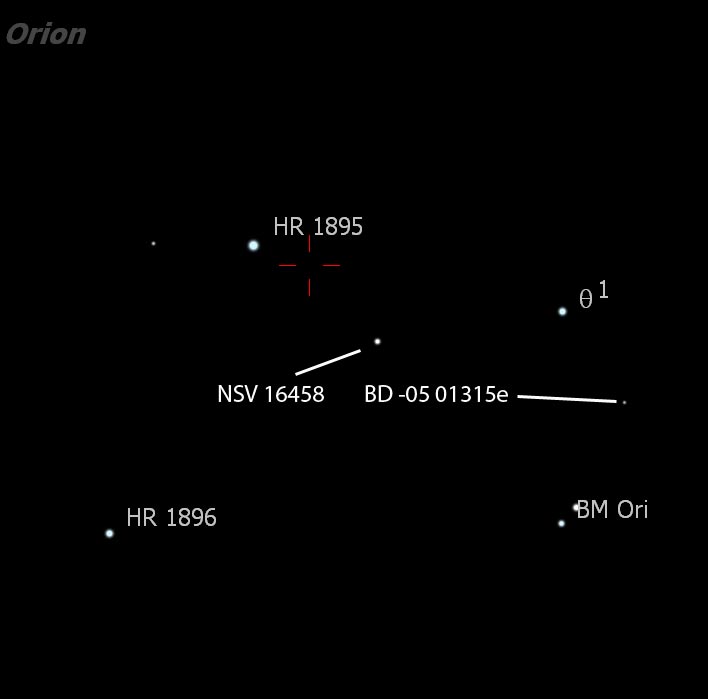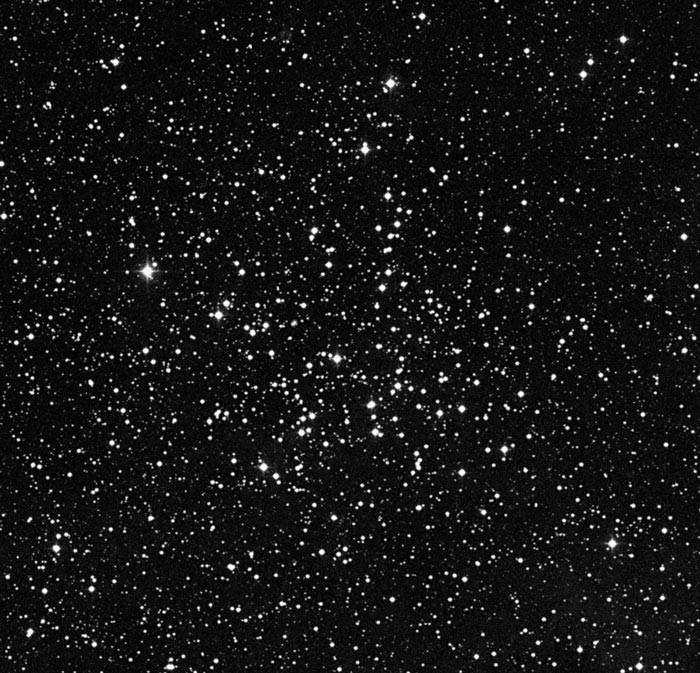Session Stats
- Air Mass: 1.9
- Session started: 00:07 GMT
- Seeing: I: perfect seeing, No quiver
- Transparency: Clear
- Moon: 16 days since New : Phase: 0.98
Orion Nebula M42 NGC 1976, Sh 2-281, Bernes 117

A magnificent sight as always. Looking at my logs the last time I observed M42 was on the 5, November of last year. And within 30 minutes too.
With a full moon 30 degrees to the East, I didn’t spend too much time looking at the nebulosity – which was still fully textured with lots of structure, but contrast was low. I wanted to get a closer look at the Trapezium and the stars contained within it, so spent most of the time observing this area.
The four principle stars that make up the Trapezium as I saw them are HR1895, Theta 1 Ori, BM Ori b and HR1896.
All were a whitish blue except BM Ori b which had a distinct warmer yellow orange hue.
In the centre of the Trapezium, the star chart shows the variable NSV 16458 at 8.4 mag. This was not observed. I find this surprising as BM Ori b is only slightly brighter at 7.9 mag. Even stranger is that BD -05 01315e which is located to the west of and in between a line drawn between BM Ori b and Theta 1 Ori, was easily seen at 11.6 mag.
Slightly more difficult to observe was BD -05 01315f an 11.0 mag component of HR1895 was just split-able with averted vision and that is if you can decide that you are not confusing it with the diffraction spike pattern of the principle component.
All this took place through the 10mm Plossl and on occasion the 4mm TMB monocentric.
Jupiter
- Date Morning of 1, Dec @ 1:17 GMT
- Seeing: I perfect with no quiver
- Transparency: Clear
- Air Mass: 1.2

Just mind blowing. Like the last time I observed, four bands were easily seen. The North Equatorial, North Temperate and Both South Equatorial belts. I didn’t spend too much time making visual observations as we wanted to try the new webcam out while conditions were excellent.
Scope: 250mm Altair Astro R.C f/8
Camera: DMK21AUG618 webcam
Image Capture: Sharpcap v1.4
F/L: 2032mm
Processing: Registax 6, best 85% frames with user selected alignment points. Only Level One wavelets applied at about 50%. Loaded into CS5 with a bit of curves and a high pass sharpen.
Moons: To the left Io and Right Europa.
I’ve added a x2 enlargement to show a little more of the detail. I wish I had added the Barlow or borrowed Frank’s x4 Powermate, as I think the conditions could certainly have stood the Barlow and possibly the Powermate.
M38.NGC 1912, Collinder 67, Melotte 36, Raab 26, OCL 433
- Session started: 01:57 GMT
- Seeing: I: perfect seeing, No quiver
- Transparency: Clear
- Moon: 16 days since New : Phase: 0.98
- Airmass: 1.0

The final object from this session and my first observation of M38.
All of the following observations were through the 26mm giving a field of view of 39arc/min although the cluster itself only covered half this angular size.
My first impression was of an inverted crucifix orientated slightly off east of North/South. The Eastern arm of the cross is made up of two parallel lines of stars ranging from 10.0 to 11.0mag. The outermost end of that arm has the light orange star HD 35878.
After a while the cross shape transforms into an ‘V’ with the point of the ‘V’ pointing towards the NW. The R/H part of the ‘V’ is formed with the Eastern arm of the Crucifix mentioned earlier with the L/H side made up of a line of stars of a similar magnitude and forming two ‘C’s on top of each other.
The final transformation made the complete cluster look like the Constellation of Hercules. This later shape wasn’t noticeable at the start of the session, but once locked in my mind, it was quite an obvious shape when coming to the eyepiece again.
All in all this was a belter of an observing session with a bit of planet webcaming to add to the mix – highly enjoyable.